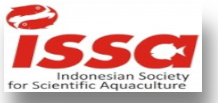Organogenesis and Development of Corydoras panda in Early Stage
Abstract
One of attractive ornamental fish species that is from Amazon, South America, is genus Corydoras. This fish has simple body ornament but unique that has black line in its eye and black spot at caudal. The color of C. panda eggs at just after fertilization tends to dark brown and to be transparence after embryo formed. Corydoras larvae possess big yolk egg without oil globule. Larva presents at the bottom of aquarium and position of yolk is beneath of larvae. Egg hatched about 51 hours after fertilization and organogenesis process taken 46 hours. Pro-larvae stage finish after 5-day-old that is marked by no yolk remained.
Keywords: organogenesis, embryo, larva, Corydoras panda
ABSTRAK
Salah satu ikan hias yang berasal dari perairan Amazon, Amerika Selatan adalah Corydoras. Ikan ini memiliki corak tubuh yang sederhana namun unik terdapat garis hitam pada mata dan spot hitam pada pangkal ekor yaitu spesies Corydoras panda. Warna telur ikan Corydoras panda pada awal fertilisasi cenderung coklat gelap dan menjadi semakin terang setelah terbentuknya embrio. Larva Corydoras memiliki ukuran kuning telur besar tetapi tidak memiliki butir minyak. Larva berada di dasar akuarium dengan posisi kuning telur berada di bawahnya. Telur ikan Corydoras panda akan menetas 51 jam pasca pembuahan dengan proses organogenesis selama 46 jam. Masa pre-larva berakhir setelah larva berumur 5 hari yang ditandai dengan habisnya kuning telur.
Kata kunci: Organogenesis, embrio, larva, Corydoras panda
Downloads
Authors who publish with this journal agree to the following terms:
- Authors retain copyright and grant the journal right of first publication with the work simultaneously licensed under a Creative Commons Attribution License that allows others to share the work with an acknowledgement of the work's authorship and initial publication in this journal.
- Authors are able to enter into separate, additional contractual arrangements for the non-exclusive distribution of the journal's published version of the work (e.g., post it to an institutional repository or publish it in a book), with an acknowledgement of its initial publication in this journal.
- Authors are permitted and encouraged to post their work online
 (e.g., in institutional repositories or on their website) prior to and during the submission process, as it can lead to productive exchanges, as well as earlier and greater citation of published work (See The Effect of Open Access).
(e.g., in institutional repositories or on their website) prior to and during the submission process, as it can lead to productive exchanges, as well as earlier and greater citation of published work (See The Effect of Open Access).






















